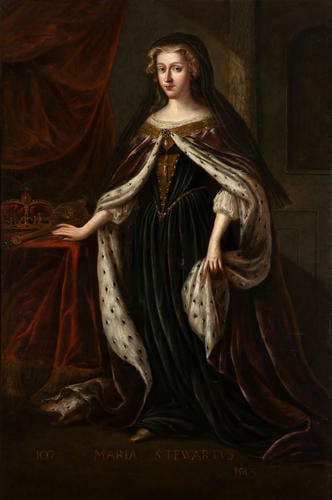Mary, Queen of Scots (1542-87) 1684-86
Oil on canvas | 214.0 x 137.0 cm (support, canvas/panel/stretcher external) | RCIN 403300
-
Full-length portrait of Mary, Queen of Scots (1542-1587), wearing a green dress with a gold stomacher and crucifix, and a purple cloak trimmed with ermine; she rests her right hand on a table on which are placed the crown, orb and sceptre.
Mary, Queen of Scots is the only woman depicted in de Wet's otherwise entirely masculine, patriarchal series. This can be explained by her dynastic importance as the mother of James VI (RCIN 403303), the first king of Scotland to ascend the English throne, as well as perhaps her dramatic life story. Mary was made Queen at barely a week old, at which time the Scottish nobility decided to marry her to Henry VIII's son, the future Edward VI. After the disastrous 'Rough Wooing' she was betrothed to the French dauphin and sent to France, where they married in 1558. After his early death Mary returned to Scotland in 1561 (now officially Protestant) and married Henry, Lord Darnley. Both were of Tudor extraction, and their marriage was a means for Mary to cement her claim to the English throne; indeed the result was the future James VI. Their union however was ill-fated: Darnley was embroiled in plots against his wife and, after the murder of her secretary David Rizzio, the upstart prince consort was himself assassinated. With her remarriage to the Earl of Bothwell – a prime suspect in Darnley's murder – combined with her unpopularity as a Roman Catholic, a coup was staged forcing her to abdicate in favour of her infant son. In 1568 Mary fled to England where she was imprisoned for the rest of her life, and in 1587 she was finally executed on the grounds of treason.
Several prototypes for this portrait of Mary are in the Royal Collection, in particular RCIN 401182 by Daniel Mytens, itself based on portraits from the life by Peter Oudry. There are no known examples showing Mary in coronation robes, suggesting de Wet invented these to make her portrait more in line with other kings depicted in the Great Gallery.
The Dutch artist Jacob de Wet II was first brought to Edinburgh in 1673 by Sir William Bruce, King's Surveyor and Master of Works in Scotland. As part of a team of skilled British and foreign craftsmen working at the Palace of Holyroodhouse, de Wet produced a series of decorative history paintings for the newly rebuilt state apartments. Still in situ, these include Bathing Scene by a River (RCIN 401237), Galatea and Polyphemus (RCIN 401238), The Apotheosis of Hercules (RCIN 401239) The Infant Hercules strangling Serpents (RCIN 401240) and The Finding of Moses (RCIN 401241). In the ensuing years he worked for members of the Scottish nobility including the Earl of Strathmore, for whom he decorated his chapel at Glamis Castle with scenes from the New Testament.
In 1684 de Wet returned to Holyrood, signing a contract with the Royal Cashkeeper on 26 February:
"The said James de Witte binds and obleidges him to compleately draw, finish, and perfyte The Pictures of the haill Kings who have Reigned over this Kingdome of Scotland, from King Fergus the first King, TO KING CHARLES THE SECOND, OUR GRACIOUS SOVERAIGNE who now Reignes Inclusive, being all in number One hundred and ten."
Today 97 of the commissioned 111 portraits are on display in the Great Gallery, with 18 kings in total depicted full-length (a final portrait of James VII & II was ordered upon his accession). Each is complimented with three bust-length portraits, 79 in total. Together they narrate Scotland's royal history. De Wet's iconographic scheme was based on well-known chronicles of Scottish history by the Renaissance humanists Hector Boece (Scotorum Historiae, 1527) and George Buchanan (Rerum Scoticarum Historia, 1582).
De Wet's 111 kings of Scotland are both actual and legendary. Their main precedent in visual art was George Jamesone's portrait series of 109 Scottish kings, of which 26 survive in private collections. Painted as part of the pageantry marking Charles I's Scottish coronation in 1633, these were later sent to Holyrood for the artist to copy, who combined this source with a number of other existing prototypes. The inscriptions on the paintings correspond with Buchanan's list of Scottish kings: from left to right, these are the number and name of the king followed by the date of accession. The dates however are considerably muddled, by a later restorer or perhaps even the artist himself.
The largest room in the palace and situated in the vicinity of the King's Bedchamber, the Great Gallery originally served as the Palace's privy gallery, making it both socially exclusive and very intimate. Its propagandistic message is clear: by endorsement of an ancient and venerable line of Scottish kings, the Stuarts were divinely appointed to rule Scotland. Moreover their rule would ensure the same peace and continuity as that of their valiant predecessors, from Fergus I the legendary first king (RCIN 403322) and Robert the Bruce (RCIN 403358), the progenitor of the Stuart dynasty. Its large scale and unique survival in situ make this ancestral series a unique and important document in the history of British portraiture.
Eleven bust-length portraits have since disappeared from the Royal Collection, possibly destroyed by Lieutenant General Henry Hawley's Dragoons who were stationed at Holyrood after their defeat at Falkirk in 1746 by Bonnie Prince Charlie. Listed in the original contract, these included Reutha, Finnanus, Metellanus, Satarell, Euthodius II, Nathalocus, Constantinus I, Donaldus IV, Dussus, Constantinus IV and Donaldus Banus.
Number 107 in the series. Inscribed MARIA STEWARTVS. 1543.Provenance
Commissioned by the Scottish Privy Council on behalf of Charles II.
-
Creator(s)
Acquirer(s)
-
Medium and techniques
Oil on canvas
Measurements
214.0 x 137.0 cm (support, canvas/panel/stretcher external)
Category
Object type(s)
Other number(s)
OM add-de WetAlternative title(s)
Mary Stuart (1542-1587)
Maria Stewartus








